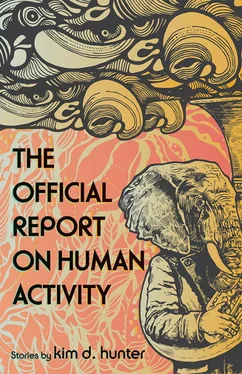In the meantime, it gave them what seemed like secret knowledge because they spoke openly, at least amongst themselves, about something no one else mentioned. It seemed that it took others longer to realize the change in the elephant’s skin, and even when those outside of their circle noticed it, they refused to acknowledge it openly.
At the height of the media attention, the deepening of the skin folds was evident even to the casual observer. But it took the obscuring of the symbols to spark public acknowledgement that something was very wrong, though that acknowledgement was not nearly as intense as the drive to understand the symbols. The shiny blackness became less black and less shiny and, for the first time, the elephant began to make noise.
The sound was surprisingly deep for a creature that was no more than four feet tall. It was voluminous. It could have come from a creature as big as the building. You could hear nothing but the sound when the elephant raised its trunk into an “S” shape and bellowed. The PA system near her in the emergency department could not be heard when she let loose. It was clearly a sound of distress and despair, but as large and overwhelming as it was, some thought they could discern finer, more nuanced emotions and messages from the sound. Those who dreamt about it were afraid to speak of it in the light. Just as the questions from the media previously had seemed to bathe the interviewees in glory, discussion of the sound brought something no one wanted to mention. “What do you think it means?” someone would ask. The response was often a shake of the head and a look towards the floor.
Veterinarians and zoologists that specialized in pachyderms were flown in, and they asked that the elephant be kept quiet, that the reporters and cameras be moved away. They were moved for a few days. The animal began to perk up. Though it stopped bellowing, the folds didn’t reverse.
But after about a week of no media coverage, people began to call reporters and media outlets to ask what was going on. The hospital legal team got an injunction to keep reporters, videographers, and other photographers away. Soon, people began to show up at the hospital. Cars circled the parking lot like vultures. People fought over the spaces. Patients and their families were being outnumbered in the lobbies and other waiting areas. Everyone wanted to glimpse the elephant. Everyone wanted to cast off the pall that came when the animal’s true condition arose in conversation. Everyone talked about deciphering the symbols. But the few who managed to struggle into the inner sanctum to actually see the animal just stared, surprised at how small it was, how the black they saw was not the black they had seen on television and other video, but was still blacker than anything they had seen or imagined. When spectators remarked on the color, the guards would close their eyes to recall the elephant’s color when they had first been brought in to guard it. Every once in a while a guard would bend down to talk to a curious child and say, “I wish you could have seen it.”
Cameras had been banned but, eventually, someone snuck one into the viewing area, recorded video of the elephant, and posted it online. It was too much for the rest of the media, especially the TV stations. A judge granted a court order that prohibited the hospital from keeping the media out. The cameras returned and the elephant’s health began failing again. The “S” shaped trunk was raised and the deafening sound returned, this time with enough force to show up as visual noise in the live video transmissions. People covered their ears. Some wore the same protective ear coverings as airport ground crews. Nothing worked.
The last thing on most folks’ minds was moving the elephant from the hospital as the Librarian’s boss was planning, but he still pressed ahead. The Librarian and the media consultant completed their respective tasks of recording and packaging a message that said the best thing for the elephant was to have it moved to where its “author” had wanted it to be in the first place. The Librarian’s boss held a news conference with the consultant and the Librarian. He showcased the recording of the Librarian even though she was there. He spoke about “the need to fulfill the wishes of the creator of the symbols so that then perhaps scholars will be able to discern their meaning.”
This was the first time anyone had publically referred to Ipso as the “author.” It set off a bit of a debate. Clearly, the elephant had emerged from him. But now that it was out, he was dead, and no one (except the Girl) could make heads or tails of the message. Was there a message? If no one could read the message, was Ipso an author? If there was a message, was Ipso the author?
The little Girl’s father was shouting so much at the TV that she ran into the room. “They don’t know what he was really like!”
“He who?” she asked.
“My brother, your sniveling uncle,” the Girl’s father replied. “His genes must have passed right through to you. You deserved him more than I ever did.”
“Deserved what?”
“Do you know what it was like? He was always distracted. He concentrated so hard when he cut the unsliced loaves of bread that he cut himself, and I always got the bloody piece. Our parents insisted on buying uncut loaves. I ate bloody bread every day until I moved out.”
“His hands must have been all scarred up.”
“That’s why the funeral had to be closed casket.”
“Because of his hands?”
Her father rounded on her, teeth bared, as he all but spat, “You don’t know what it was like.”
She didn’t reply. She had suddenly recognized one of the people on TV, the woman in the flowing dress.
Besides the elephant, the blackness of the elephant and the clarity of the silver, seeing the storyteller was the best thing about her life at the moment. It was also unbelievably wonderful that the storyteller was somehow involved with the elephant. The red-faced man with the perpetually moving lips spoke a comprehensible word or phrase now and again. He wanted to move the elephant, and every time he mentioned the idea, the storyteller would nod. The woman next to the storyteller didn’t seem as connected to the event that was taking place, while the storyteller was brimming like the man who couldn’t stop moving his lips and whose tongue occasionally came into view. This other woman was looking around as though she wanted to keep the looking around a secret. The Girl could feel her making notes.
The storyteller seemed a bit like the elephant because there were two parts to her color, at least two parts. Clearly she was dark and light, not as dark as the woman making notes, not as light as the red-faced man. But the real joy was that the storyteller and the elephant were somehow connected, that the storyteller, at least according to the red-faced man with lips in constant motion, was helping to save the elephant.
It is so good that I am awake and not dreaming , the Girl thought.
The Librarian’s boss’s campaign to move the elephant to the library hit some snags. None of the people with veterinary experience supported the animal being moved. He needed an ally, and while he tried to finagle connections and support on the medical front, he sent the Librarian over to talk to the Egyptologist. It just so happened that the reporter was also there. Juggling these two requests for his time reminded the Egyptologist of the days just after the elephant had emerged, days with more kineticism and exquisite meals than he’d ever known. It was the reporter, hoping to make the interview a twofer, who insisted that the Librarian, who had identified herself as such to the administrative assistant, be allowed to remain present during the interview. The Egyptologist, hungry for what he assumed would be good publicity, agreed.
Читать дальше












